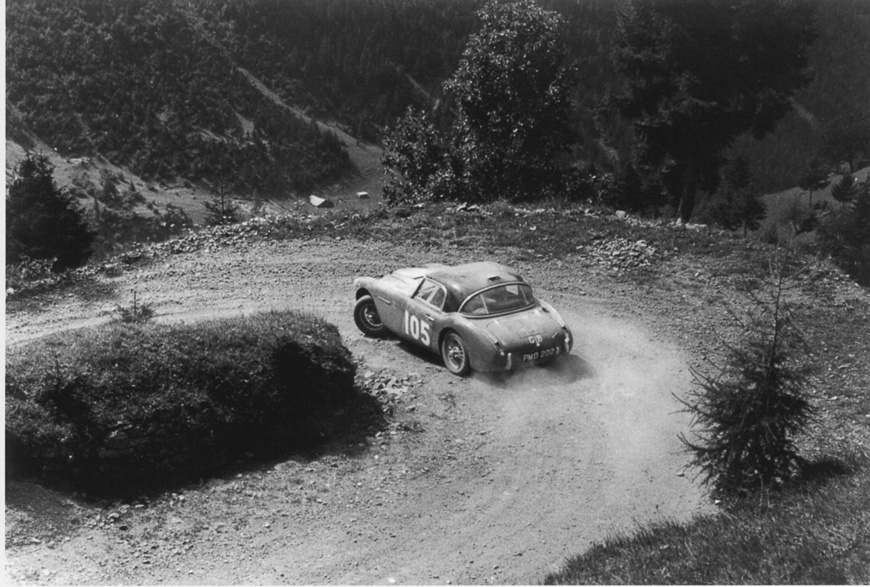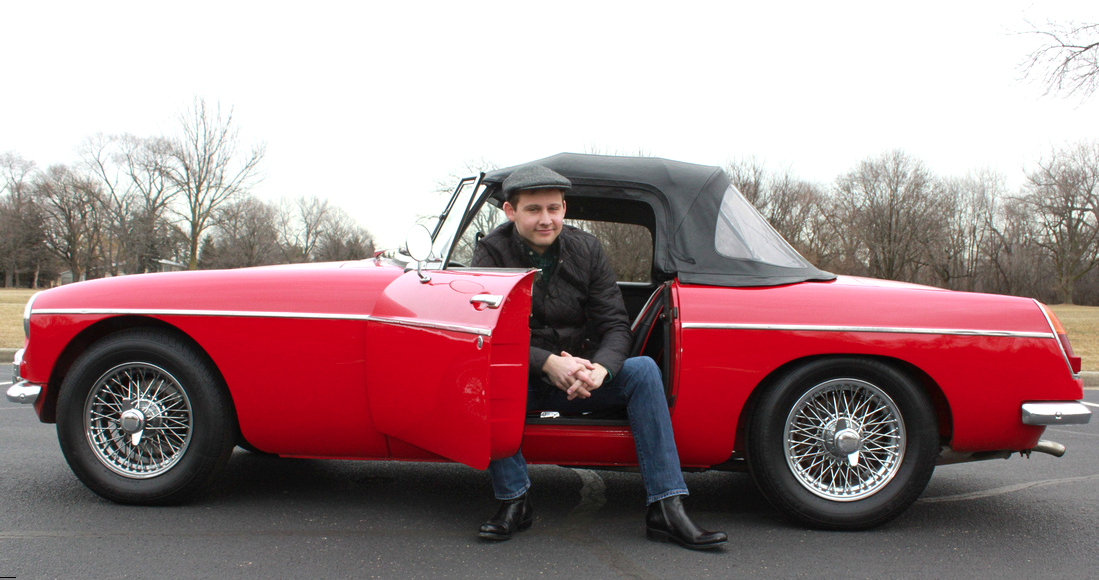The Legacy of Yesterday’s Mountain Climbers
I sometimes wonder if the British cars that we collect, restore and love so much still carry with them the legacy of the rallies and races in the 1950s and sixties. Back in those Golden Days of motor sport, the cars not only had to look the same as the ones on the street, only polishing, shaping and balancing of the original parts was allowed. You could not even change the valve springs. Those of us who drove Austin Healey Sprites knew only too well the restriction this placed on engine performance above 5,000 RPM.
One of the greatest of all the classic rallies was the Coupe des Alpes, or “The Alpine,” as we called it. Dating back to pre-World War II days, the competition attracted around fourteen or fifteen three-car works teams, but not many private owners because of the high cost and virtual certainty of wearing out or crashing your car. This was not a vast test of endurance, but much more a speed challenge across many dozens of the steepest and tightest Alpine Passes.
A Social Sport

1961 Alpine Rally, on the quais in Marseilles. The rally was usually so hot that most crews wore shorts.
The three days of competition were normally fifteen or sixteen hours each in length, after which a twenty-four hour rest stop in some delightful ski resort like Chamonix, gave us time to recharge our batteries and eat a couple of decent meals in unhurried manner. In my day, the Automobile Club of Marseilles and Provence ran the event, but originally this task was split between clubs and even countries. The late motoring journalist Tommy Wisdom, one of Donald Healey’s drivers in race and rally for several decades, told me of the 1930s’ events when he used to pack a trout fly rod, so that he could squeeze in a bit of fishing during the stops when the rally was held over a full week of driving. No rest for the cars, though, they were impounded in parc fermé and no work was permitted on our tiring and worn out automobiles.
Another challenge was the short length of the stages themselves, mostly just thirty or forty minutes of hectic motoring, which gave little or no time for any service or repairs and of course the special stages over the mountain sections were at target speeds which were barely achievable. To make it worse, the timing for each of these sections was set at what had been achieved by the fastest car in each class the previous year.
Additionally a number of pure speed hill climbs were set, where one had to be within 10% of the fastest time to remain unpenalised, which meant that our Sprites for example, were hard put to keep within sight of Ferraris and Porsches when it came to climbing steep mountain passes. Downhill was not such a problem except for the nasty smell of fading brake linings in the pre-disc era, and the occasional gasps from the co-driver. We had been known to push open both doors on the Sprite in order to give a little air-brake assistance to the slowing procedure when descending towards unfenced hairpin bends.
Peaks to City Streets
In addition to a couple of days on the French and Austrian Alpine passes, we were also obliged to trek across the minor roads of Northern Italy to Monza, for a succession of five lap races where each class competed. This was a simple ruse to prevent any of the competitors from using a very short final drive, which would obviously help in climbing mountains, but would severely restrict top speeds and drop one far more than ten percent behind the fastest speeds which were possible on this very fast track in the days before all the Mickey Mouse chicanes were incorporated to try and slow everything down. After that, we headed into the Dolomite Mountains, where the passes went up to around 9,000 feet or so—fairly smooth on the Stelvio, with its 48 hairpin bends, but far rougher on the unmade tracks of the Gavia and Vivione. An odd thing for this altitude was that SU carburetors managed to compensate for the change in air pressure, while the Webers did not. As the Healeys were by now running triple Webers, the team was accompanied by an ace mechanic whose job was to change the jets at the start of this trio of climbs, to allow the cars to use maximum power on the climbs, and then to change the settings back to normal at the end of the section.
Up until 1958, the rally ended with a five lap race at the circuit of Pierre Wimille. Set close to the Le Courboisier designed housing complex, this mini-Monaco course included curbs and roundabouts and tight corners on roads that were oil saturated from heavy daily traffic in the very hot conditions of the South of France. With the prize giving table of awards not too far away, people did not take too many risks, but it was certainly a fun way to end one of the finest events in the calendar.
The Elusive Cup

Sometimes it all goes wrong. In second place among the GT cars, on the final stage, the steering column came adrift from the rack.
The object of the rally was to maintain an unpenalized run throughout at the seventy or so timing points, thus winning you a “Coupe des Alpes.” Very, very few of these were awarded each year, and to win three in a row gained a Gold Cup, of which only two were ever won in my day—by Ian Appleyard in a Jaguar XK120 and by Stirling Moss in Sunbeam Alpine sedans. Two others earned Gold cups in the seventies.
Half a dozen folks won Silver Cups for three non-consecutive penalty-free runs, and among these were Healey’s Morley twins, Donald and Erle, who dominated the event in the early sixties with their Austin Healey 3000. Stirling’s third win was in spite of losing a couple of gears and, as you have to have them all working at final scrutineering, he managed to fool the inspector by chatting furiously (something that was not unusual for him anyway) while stirring the selector in and out of first and then in and out of top, slipping the clutch as required, and presenting four forward gears and passing the check. That same year, one of the tests was a speed test on a Freeway, where the average speed was one hundred miles per hour. As it was absolutely teeming with rain, Stirling inflated his tires to around sixty pounds per inch, and was the only member of the Sunbeam team to achieve this speed and remain without penalty.
1958 Sprite on the way to a class win on its first international outing. Climbing Mont Ventoux. The cuts in the bonnet are to get at oil and water, as I had knocked and jammed the handle which opens the front.
Sadly, the increasing traffic even on the minor mountain roads during the summer days when the rally was held put an end to this magnificent challenge. The cost of policing every single junction on the route became impossible to finance out of the entry fees and all we have left are some super memories. If you ever get the chance, the Shell film of the 1958 Alpine Rally, remains one of the finest portraits of the challenges of rallying in those Golden Days. Dozens of cameramen followed us around, driven by serious professional drivers, which produced some of the most accurate scenes of the danger of rallying. Only the sound track—dubbed after the event with recordings made at a British race track—is a little suspect. Even I cannot ever remember tires squealing on loose gravel surfaces.
Click to view the Shell film “Coupes des Alpes” on YouTube.
By John Sprinzel











'To Race the Alps' have 4 comments
October 5, 2012 @ 9:40 am Dean
Wonderful article. I’m grateful for this article, because I missed your presentation at the Sprite 50th.
Thanks.
October 5, 2012 @ 12:20 pm mojo risin
Thanks John, always thoroughly enjoy you sharing your adventures with us.
October 30, 2012 @ 9:55 am mark Zemke
Wonderful article and the film is priceless. does anyone know what the Blue French vehicle driven by some ladies is?? has some ques from an early TVR but the snout is very long, someone has thought it may be a Panhard special ??
May 5, 2013 @ 11:38 am The Young Crazed Peeling | Cyril and Vivian
[…] The Stelvio Pass in northern Italy. Photo courtesy of Moss Motoring […]